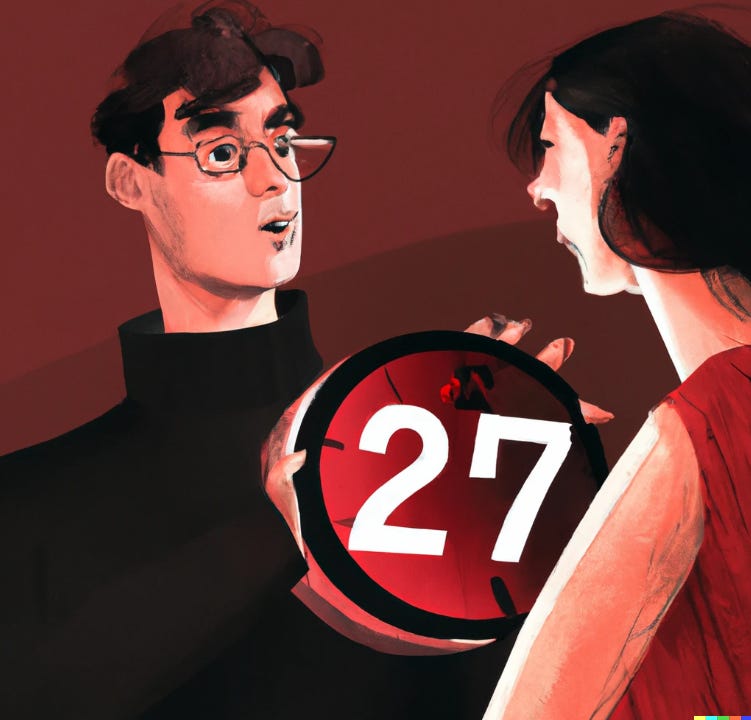Today I was late for a Zoom meeting.
The meeting was to begin at 9 am. I logged on at a few seconds past 9:03.
“I’m so sorry I’m late. You know, Zoom to Zoom today, no break for a pee!”
The other 3 participants laugh, in that half-legitimate, half-“I already laughed at that comment 100 times in the last 2 years and it’s actually kind of real and not all that funny so why is it still coming up”-kind-of-way.
We get back into the call. From 9:03 to 9:05 we allow ourselves the “unrestrained” freedom to ask about each-other’s weekends. Each participant reports, the others half-smile again, and at 9:05 sharp, my colleague’s eyes glance down to the time in the corner of her screen.
“Well, should we get into it?” she asks.
Yes, let’s get into it.
Twenty three minutes of unstructured discussion goes by before I see the time — 9:28. We haven’t really got to what we came here to discuss, but alas, we’ve all got more Zooms at 9:30.
“I see we’re running up on time here, should we make a decision?”
I quickly compartmentalize my thoughts. 90 seconds, 3 points, 20 seconds each plus a conclusion. 30 more seconds of verbal approval from the rest of the group. And we’re done. Boom! Structure, reasserted like a 6th grade teacher who just dropped the 5 paragraph essay for the first time.
We came, we caught up, we discussed, and we decided.
And we’re off — off to the next Zoom.
Productivity, am I right?

There wasn’t anything so special about this meeting. It’s become the norm over the past few years.
Today, though, I was feeling particularly curious. Maybe because I’ve been reading some sociology recently.
Reading sociology is weird. It feels like you’re reading history, but then all of a sudden you’re three pages deep and you realize you’re still analyzing the same precise moment in time: a couple sitting down at their dinner table, a man waiting for the bus, a young kid feeding the ducks in the park. Moments that, at the time they occurred, probably didn’t feel so special. But wow! How much significance every detail holds within — what each says about the time, the place, the people. Dissected like a human body.
So today, I had a moment.
What would sociologists say about this meeting that just happened? What would they say today, ten years from now, fifty years from now?
In this all-too-mundane thirty minute Zoom meeting, what did we accomplish? How did people walk away feeling? Who was in charge and how did the group dynamics play out? What social norms directed the flow of engagement? And what does all that say about this moment in time?
It occurred to me: none of us were ‘in charge’.
Our clock was.
The clock, always present and never still, visible without any need for searching. Three small numbers that mean nothing to a 5-year-old but everything to us: what to say, how fast to say it, all right there.
Subtly or not, those digits in the corner of the screen hold many rules of engagement. How much information should I share? How ‘significant’ is this meeting to the other? What level of interpersonal connection are we seeking here?
That may sound like an overstatement to many, but try this scene.
It’s 2:23PM. You’re standing at the front of a conference room, presenting to a team of your seniors. You’ve been working on this project for months, and you’re on great terms with everyone in the room, but you know you need to land this presentation right.
It’s a perfectly normal conference room, a perfectly normal scene.
Except: in this scene, each person has a bright digital clock placed directly in front of them at the table, close enough that you could glance at the time without them noticing you lost eye contact.
And, in this scene, you know that at half past the hour, on the dot, every person in the room will be immediately whisked to another place, another meeting, another context.
Do these two small nuances change how you show up?
If this were a scene in a movie, these two small details would be the difference between a team of students collaborating on a project, and a young, hungry actor auditioning for a role in a movie she knows she probably won’t get.
Yes, these two details — they change so much about this moment.
Thirty minutes have become so significant over the past few years. Everything seems to be thirty minutes now. A quick ask that could be an email, a catch-up that should be a lunch. What the hell is so special about 30 minutes?
And why are there no breaks? (By the way — we tried setting our default meeting time to 25 minutes — let’s be honest, nobody cares).
I’ve recently begun opting for in-person meetings wherever possible. I meet for coffee - find parking, use the restroom, put in my order.
A 9 am coffee may start at 9:01 or 9:06 or 9:15. I buffer an hour in my schedule, and it may take half that.
The time? It still matters. I have things to do, places to be — we all do.
But it’s not quite the same.
We are now living and constructing our actions around the movement of the second hand, like a basketball player who eyes the shot clock with precision.
There is a flow, an order between us, the people here. How long this engagement takes is not dictated by any particular clock, but by a mutually-understood sense between us. When you meet someone for coffee, you just know when it’s time to get to business, when the chit chat has gone on enough, when the moment of departure has arrived.
How do you know? You know because you are a social being. How you interact with others — your social norms — are constructed by the group, the community you belong to.
You may not always like it. You may think first dates should be short and quick, not full-on dinners.
But the people around you decided that norm. And, critically, you can change that. We each play a part in building our communal norms. It’s slow, gradual - but look at the differences in how a 90s kid and a baby boomer interact and you know it’s there. Person-to-person, small group-to-community, city-to-state: you are a part of creating those social norms.
Of course, the physical world around us reinforces behaviors and holds up social norms. The layout of streets, the placement of mailboxes and bus stops — these small things change how we connect with the people around us, as countless studies have shown (famously, how something as small as whether neighbors place their mailboxes on the street or at the door has has a huge impact on their likelihood of engaging with each-other).
Technology as behavior-enabler
But what happens when technology is a part of that physical world — when our technology helps dictate our social norms?
Where street layouts and bus stop placements are decided by committees with processes and meetings and stakeholder input, who decides the settings on your calendar app?
Theoretically, you do.
Nobody is forcing you to set a 30 minute meeting, nobody is even forcing you to use Zoom.
But everyone else is doing it, so, you do too.
The outcome that wins? Whatever is default.
That one Google product manager, probably 24 years old, who drew up the initial product requirements doc for the Google Calendar “New calendar event” flow, without much thought put down 30 minutes as the default calendar event time.
With barely any thought, that 24 year old completely changed the behavior of millions of human beings.
“People can choose whatever time they want, so it’s not a big deal,” he may have thought.
But people won’t choose whatever time they want. Because they’re lazy and they don’t actually know how long this meeting should be, nor do they want to think much about it.
And before you know it, people are so used to thirty minutes that it just becomes normal. ‘Default’ wins.
The problem here is not that social norms are being changed, or that they are necessarily bad.
The problem is the power of that change is concentrated in the hands of a very, very small group of individuals, and most are unaware of the power they hold.
Those who make the tools set the rules. And when those tools present to the user an appearance of control, the user asks no questions, falsely believing they set the rules.
That’s a scary thought — the dissolution of our individual power, occurring inconspicuously in front of our eyes.
Scarier, in my opinion, than wires tied into our brains.





Hey Rafi, great thought piece! I'm really wrestling right now with how technology, social norms, etc. have too much of a hold on my life and time, and how to get free. I recently heard about this consultant and her website peaked my interest; sharing in case it interests you. cofinityconsulting.com